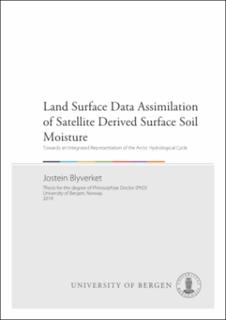| dc.contributor.author | Blyverket, Jostein | |
| dc.date.accessioned | 2019-10-28T08:30:11Z | |
| dc.date.available | 2019-10-28T08:30:11Z | |
| dc.date.issued | 2019-10-21 | |
| dc.date.submitted | 2019-10-03T11:59:50.645Z | |
| dc.identifier | container/78/5d/c4/03/785dc403-b6e9-484e-a138-6b99e037eb29 | |
| dc.identifier.uri | https://hdl.handle.net/1956/20940 | |
| dc.description.abstract | The ability to accurately determine soil water content (soil moisture) over large areas of the Earth’s surface has potential implications in meteorology, hydrology, water and natural hazards management. The advent of space-based microwave sensors, found to be sensitive to surface soil moisture, has allowed for long-term studies of soil moisture dynamics at the global scale. There are, however, areas where remote sensing of soil moisture is prone to errors because, e.g., complex topography, surface water, dense vegetation, frozen soil or snow cover affect the retrieval. This is particularly the case for the northern high latitudes, which is a region subject to more rapid warming than the global mean and also is identified as an important region for studying 21st century climate change. Land surface models can help to close these observation gaps and provide high spatiotemporal coverage of the variables of interest. Models are only approximations of the real world and they can experience errors in, for example, their initialization and/or parameterization. In the past 20 years the research field of land surface data assimilation has undergone rapid developments, and it has provided a potential solution to the aforementioned problems. Land surface data assimilation offers a compromise between model and observations, and by minimization of their total errors it creates an analysis state which is superior to the model and observation alone. This thesis focuses on the implementation of a land surface data assimilation system, its applications and how to improve the separate elements that goes into such a framework. My ultimate goal is to improve the representation of soil moisture over northern high latitudes using land surface data assimilation. In my three papers, I first show how soil moisture data assimilation can correct random errors in the precipitation fields used to drive the land surface model. A result which indicates that a land surface model, driven by uncorrected precipitation, can have the same skill as a land surface model driven by bias-corrected precipitation. I show that passive microwave remote sensing can be utilized to monitor drought over regions of the world where this was thought to be impractical. I do this by creating a novel drought index based on passive microwave observations, and I validate the new index by comparing it with output from a land surface data assimilation system. Finally, I address knowledge gaps in the modelling of microwave emissions over northern high latitudes. In particular, I study the impact of neglecting multiplescattering terms from vegetation in the radiative transfer models of microwave emission. My three papers show that: (i) land surface data assimilation can improve surface soil moisture estimates at regional scales, (ii) passive microwave observations carries more information about the land surface over northern high latitudes than explored in the retrieval processing chain and (iii) including multiple-scattering terms in microwave radiative transfer models has the potential to increase the sensitivity for surface soil moisture below dense vegetation, and decrease biases between modelled and observed brightness temperature. In sum, my three papers lay the foundation for a land data assimilation system applicable to monitor the hydrological cycle over northern high latitudes. | en_US |
| dc.language.iso | eng | eng |
| dc.publisher | The University of Bergen | en_US |
| dc.relation.haspart | Paper I: Blyverket, J.; Hamer, P.D.; Bertino, L.; Albergel, C.; Fairbairn, D.; Lahoz, W.A. An Evaluation of the EnKF vs. EnOI and the Assimilation of SMAP, SMOS and ESA CCI Soil Moisture Data over the Contiguous US. Remote Sensing 2019, 11. doi:10.3390/rs11050478. The article is available in the main thesis. The article is also available at: <a href="http://hdl.handle.net/1956/20718" target="blank">http://hdl.handle.net/1956/20718</a>. | en_US |
| dc.relation.haspart | Paper II: Blyverket, J.; Hamer, P.D.; Schneider, P.; Albergel, C.; Lahoz, W.A. Monitoring Soil Moisture Drought over Northern High Latitudes from Space. Remote Sensing 2019, 11(10). doi.org/10.3390/rs11101200. The article is available in the main thesis. The article is also available at: <a href="http://hdl.handle.net/1956/20696" target="blank">http://hdl.handle.net/1956/20696</a>. | en_US |
| dc.relation.haspart | Paper III: Blyverket, J.; Hamer, P.D.; De Lannoy, G. Quantifying Higher Order Vegetation Scattering Effects in Passive Microwave Observations from SMAP over Northern Latitudes. The article is not available in BORA. | en_US |
| dc.rights | In copyright | eng |
| dc.rights.uri | http://rightsstatements.org/page/InC/1.0/ | eng |
| dc.title | Land Surface Data Assimilation of Satellite Derived Surface Soil Moisture : Towards an Integrated Representation of the Arctic Hydrological Cycle | en_US |
| dc.type | Doctoral thesis | |
| dc.date.updated | 2019-10-03T11:59:50.645Z | |
| dc.rights.holder | Copyright the Author. All rights reserved | en_US |
| dc.contributor.orcid | http://orcid.org/0000-0003-1777-1971 | |
| dc.identifier.cristin | 1736949 | |
| fs.unitcode | 12-44-0 | |
